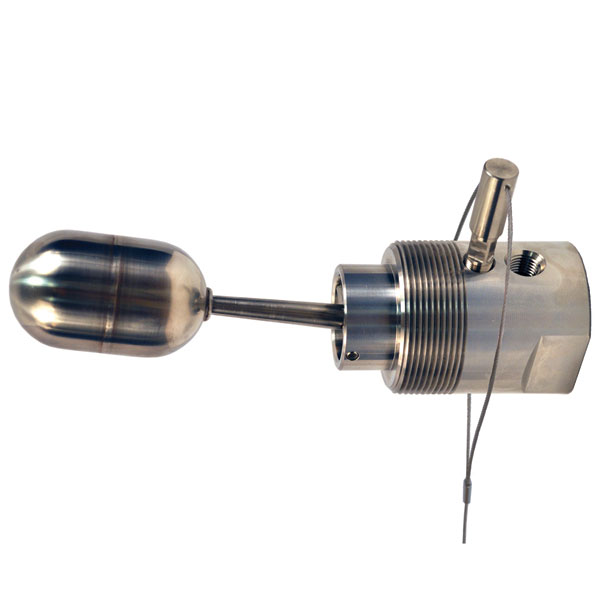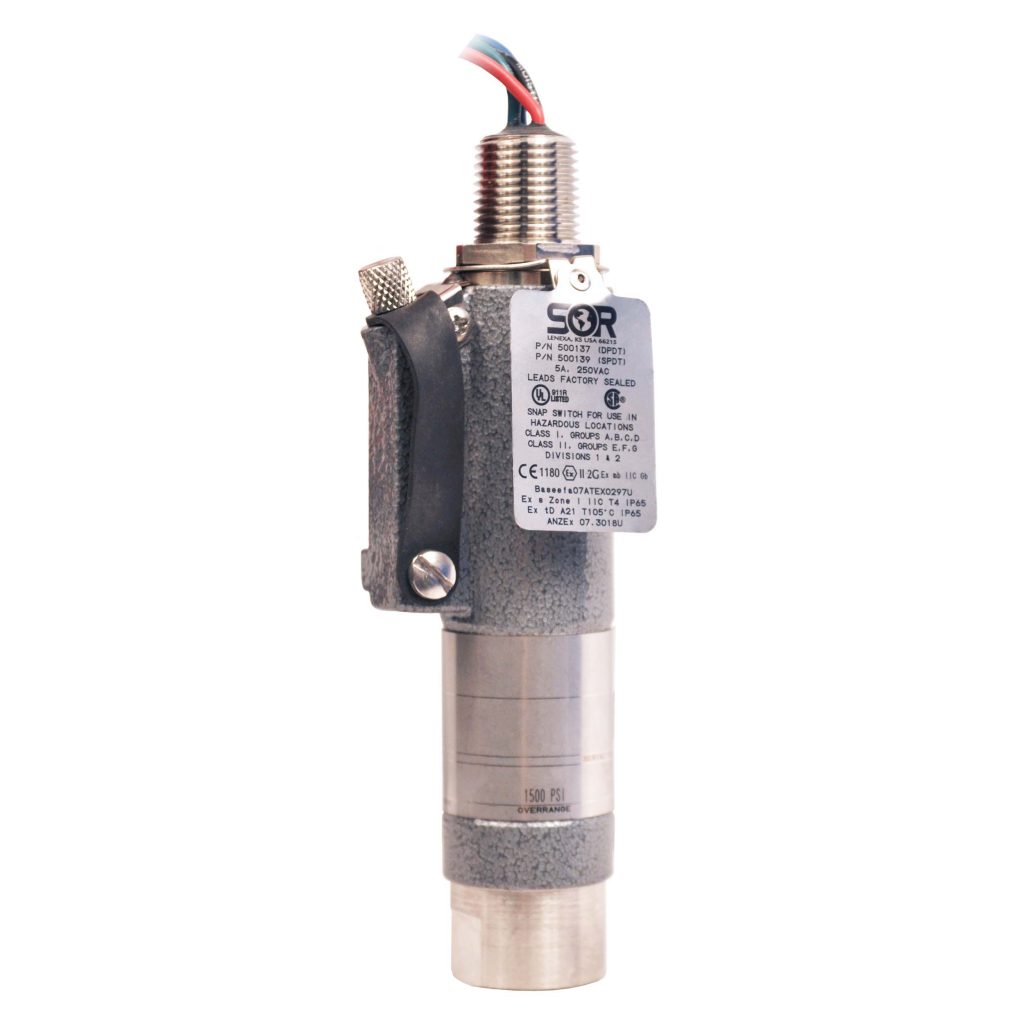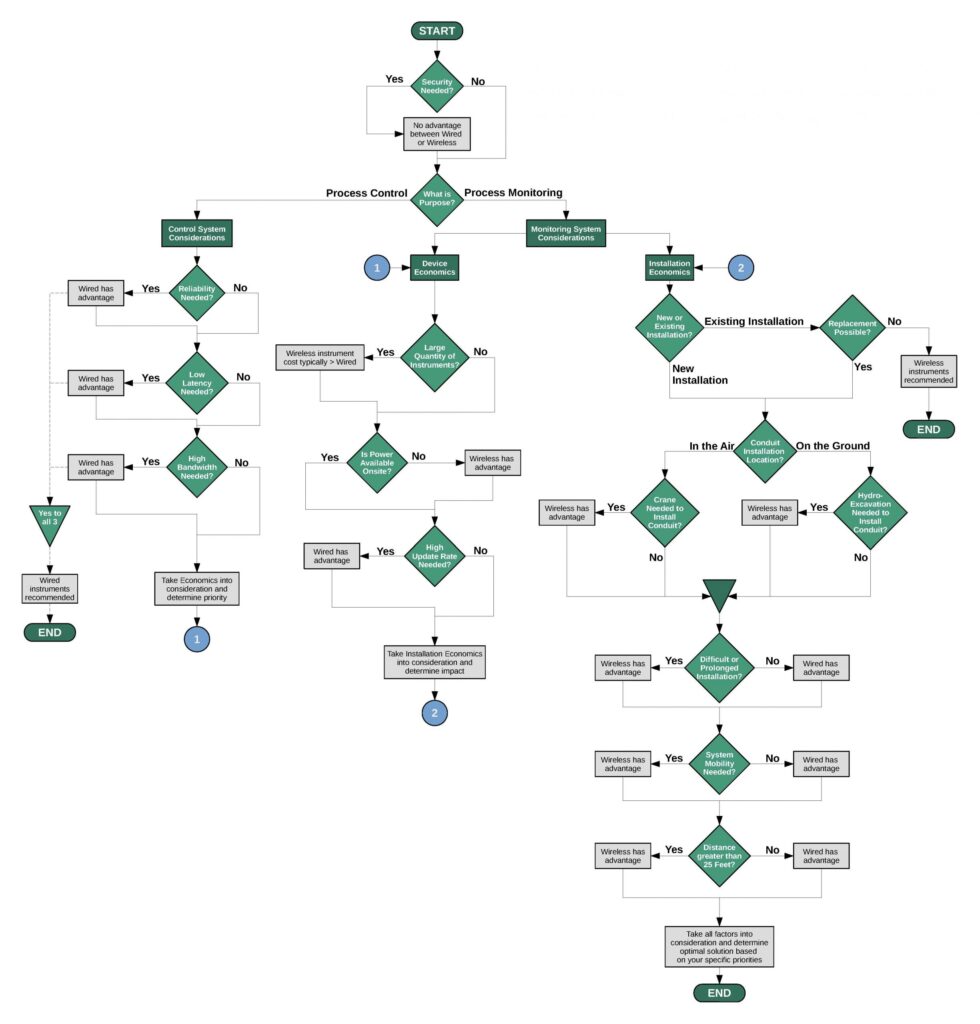
Wired or Wireless – A Practical Approach to Making the Right Selection(PDF)
A Practical Approach to Making the Right Selection.
Decision Tree
With all the information available for wired and wireless instruments, how do you choose which one to use? It is a difficult decision since either choice has its tradeoffs, so several factors must be considered to find the optimal solution. To simplify the process and ensure no considerations are overlooked, one can use the decision tree from this paper to help reach an informed conclusion.
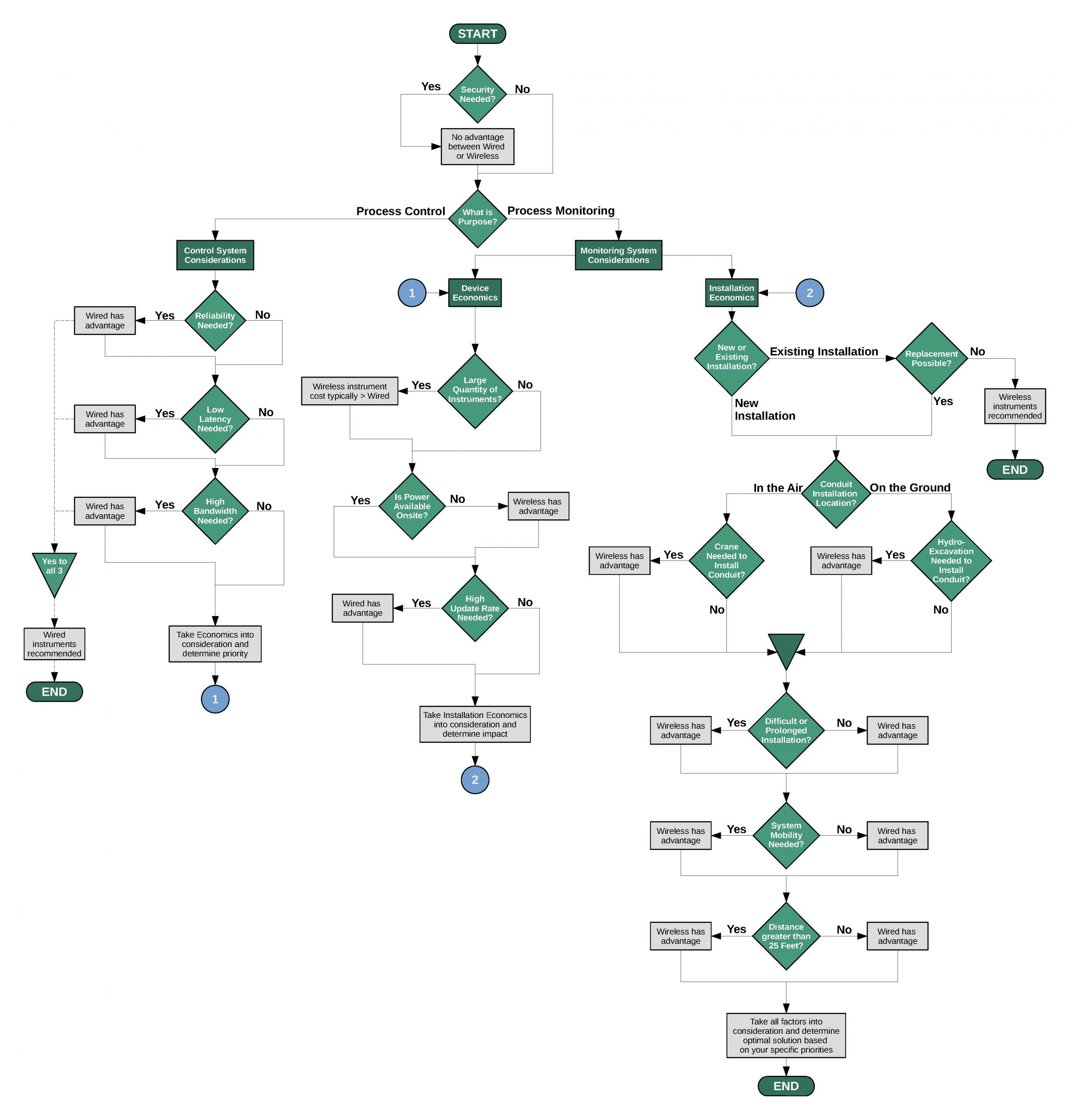
Security
When starting down the decision tree, the first factor you face is device security.
These days, most wireless instruments have built-in security; however, regardless of whether the instrument is wired or wireless, to truly prevent intrusion designers must look at the system level as opposed to each individual device. In many cases, the system includes both wired and wireless instruments, which each have vulnerabilities needing protection. For 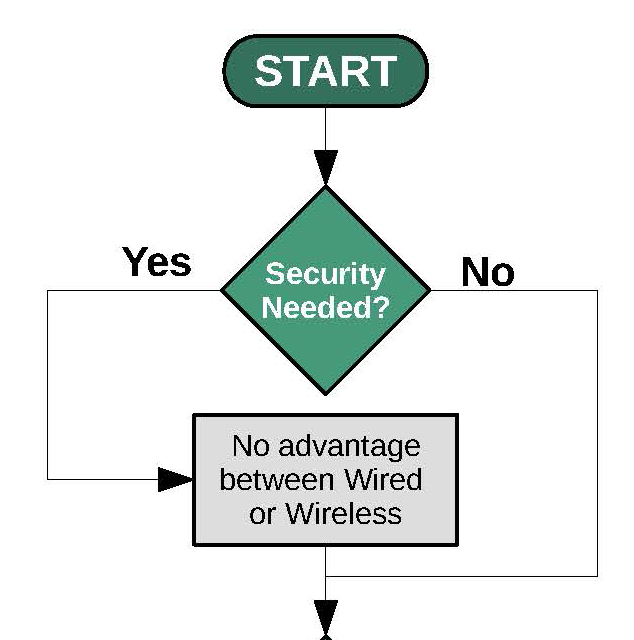 wireless systems, someone with an antenna could penetrate the signals and intercept data or disrupt the network by overloading it with large amounts of dubious messages intended to cause other communication devices to compete for bandwidth. On the other hand, when wired systems are connected to the outside world it opens the network to a whole host of potential entry points.
wireless systems, someone with an antenna could penetrate the signals and intercept data or disrupt the network by overloading it with large amounts of dubious messages intended to cause other communication devices to compete for bandwidth. On the other hand, when wired systems are connected to the outside world it opens the network to a whole host of potential entry points.
Incursion into company networks, whether through an attack on a wired or a wireless system, can be costly in terms of capital, manpower, and disruption of operations, and while security is an important factor for any system, there is no significant advantage to using wireless instruments over wired.
Purpose
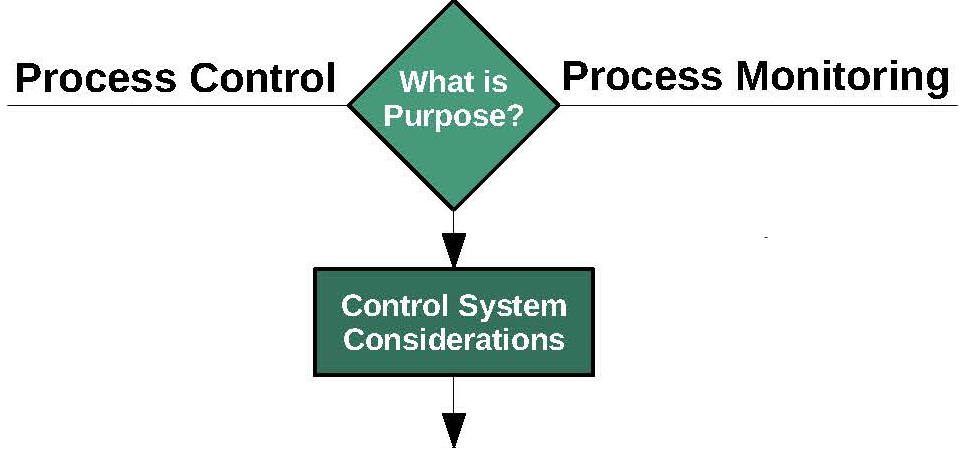 After security, the next question asks about the purpose of your system. Specifically, whether the system is being used to control or monitor a process. The system purpose is often the primary factor that impacts whether to use wired or wireless instruments.
After security, the next question asks about the purpose of your system. Specifically, whether the system is being used to control or monitor a process. The system purpose is often the primary factor that impacts whether to use wired or wireless instruments.
Let us first explore the case of a system used for process control. When selecting instruments for a process control system, there are three important factors to consider: Reliability, Latency, and Bandwidth.
Reliability
Reliability is the most significant characteristic when the device is used in a control application. If the signal being sent to a controller is not reliable the process may not operate correctly; in the most severe cases, this could result in loss of life or property. Reliability applies to both wired and wireless solutions; in the case of wired instruments, false readings or no readings could occur if the wires are not properly terminated. For wireless instruments, incorrect information could be 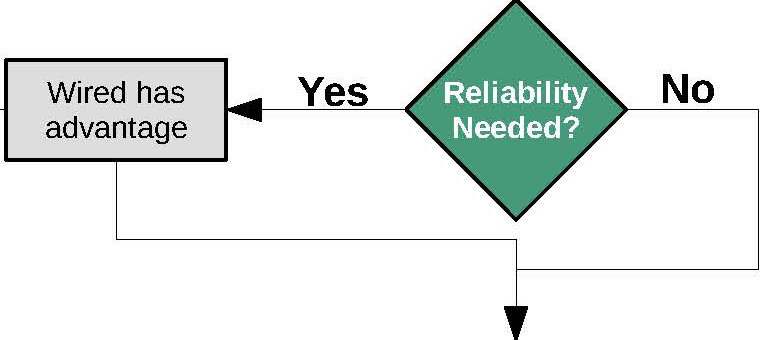 brought into the controller if the channel does not provide ways to correct for errors in the communications, which would lead to the controller inappropriately making decisions based upon the bad data.
brought into the controller if the channel does not provide ways to correct for errors in the communications, which would lead to the controller inappropriately making decisions based upon the bad data.
In the end, wired instruments are more reliable than wireless instruments by the sheer nature of their design and how they communicate with the system.
Latency
In general, wireless instruments will have higher latency than wired instruments. However, there are many factors that can influence the latency of data communications; it can be impacted by processor speed of the computing environment, available memory, communication rates, distances communication is traveling, data packet size, and protocol utilized. That said, in some cases these factors may not affect latency in any way.
A test was performed on Modbus TCP vs. Secure Modbus at an experimental power plant. With Secure Modbus, one would expect that the additional requirements of RSA-based schemes to confirm access would add latency compared to Modbus TCP. However, even with the larger packet sizes for Secure Modbus, this test proved there is no noticeable difference in latency, as seen in Table 2 (Nai-Fovino, 94).
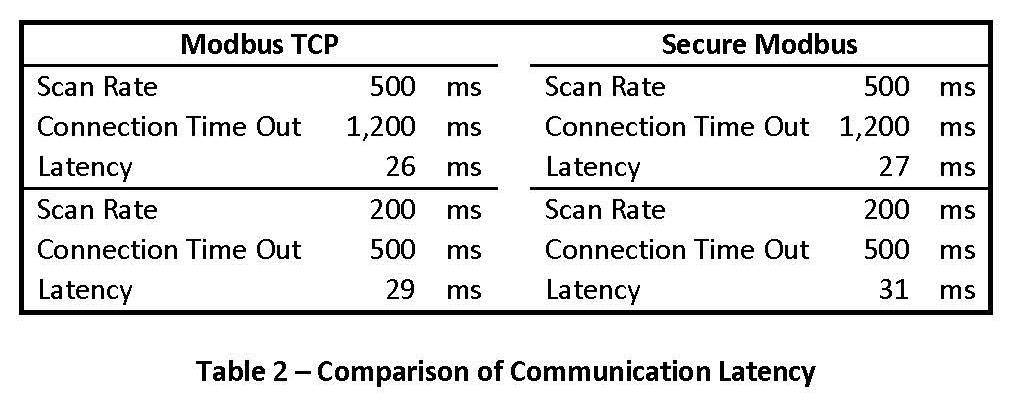
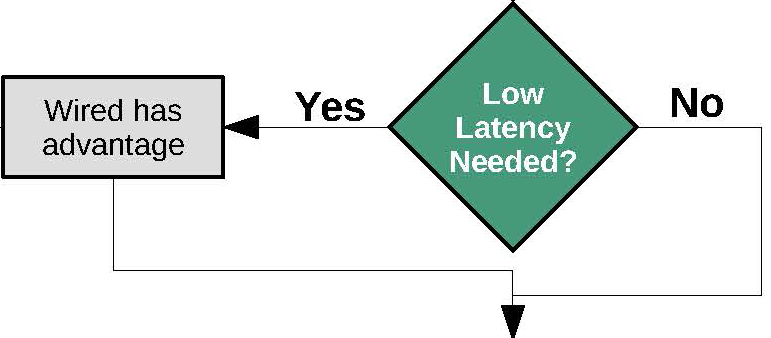 Ultimately, latency’s impact is largely dependent the application. For monitoring systems, a wireless latency of 50 ms may be acceptable. On the other hand, control systems always need to respond quickly when an event occurs, making wired instruments the better choice.
Ultimately, latency’s impact is largely dependent the application. For monitoring systems, a wireless latency of 50 ms may be acceptable. On the other hand, control systems always need to respond quickly when an event occurs, making wired instruments the better choice.
Bandwidth
In this case, the bandwidth we are referring to is the system bandwidth, as opposed to signal bandwidth, although both are important. System bandwidth is a function of the channel the data is passing through; in a wired system, the wiring is the channel, be it copper or fiber optic cable; for a wireless system, free space is the channel. Most conditions that impact free space typically have a negligible impact on a wired channel.
Wired channels have varying degrees of influence on bandwidth, with fiber optic being superior to copper. Copper wiring has issues with temperature, skin effects, and long distances, all of which, create added impedance to the signal reducing the overall signal to noise ratio.
Temperature, humidity, atmospheric pressure, and other natural occurring physical properties influence bandwidth of the free space channel. When noise from these sources is injected into the channel, it eliminates, or possibly attenuates, the signal strength which affects the frequency, speed of data transfer, and the magnitude of the signal. For wireless systems, many techniques have been developed to counteract these issues, such as spread-spectrum technologies and error coding within the communications protocol. Modern wireless systems also incorporate design techniques that provide the communication protocols ways to help eliminate issues such as multi-path errors, where the same signal gets picked up from a reflection off an object in a different path to the antenna. 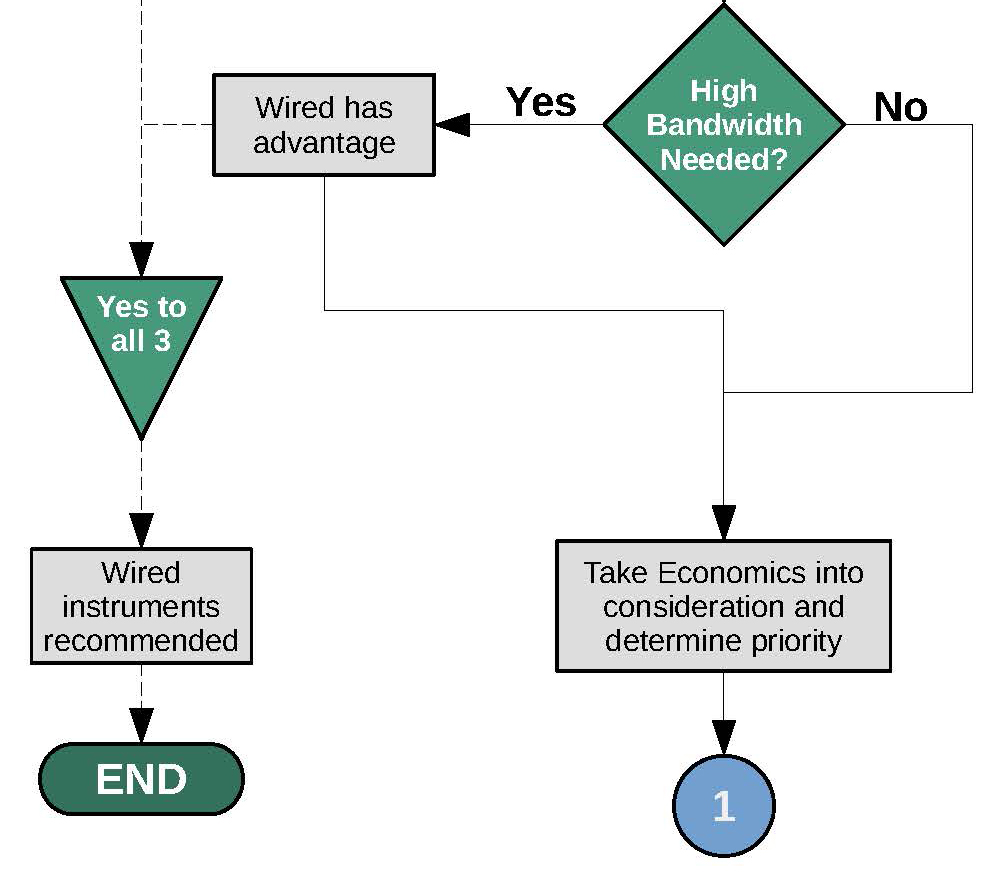
In contrast, these physical properties have no impact on a fiber optic cable, and as such, the bandwidth is significantly higher and more reliable. Thus, wired systems have the advantage when it comes to bandwidth, with fiber optic cable surpassing copper wire.
When it comes to process control, wired instruments are the recommended choice. Regardless of the economics, wired instruments are typically preferred because they minimize the potential risk of process failures.
However, if process failures are not a major concern, but more of an irritation, then the economic considerations should be factored into your decision.
This brings us back to the path of a system used for process monitoring. While reliability, latency, and bandwidth are still necessary for systems monitoring processes, their influence normally pales in comparison to the economic factors of choosing wired or wireless instruments.
In the decision tree, the economic factors are grouped into two general categories: the device economics and installation economics. We will start by looking at the device economics. More often than not, the installation economics will be the major driver in your decision to use wired or wireless; however, the device economics are important and should still be evaluated and taken into consideration.
Device Economics
 When evaluating the economics of the decision, a common mistake many people make is only considering the cost of the instruments themselves. A wired instrument is generally less expensive than a wireless one, due to the additional circuitry associated with the wireless interface. The instrument cost does play a role, but you must be careful not to overlook the other factors related to device economics, which are the power costs.
When evaluating the economics of the decision, a common mistake many people make is only considering the cost of the instruments themselves. A wired instrument is generally less expensive than a wireless one, due to the additional circuitry associated with the wireless interface. The instrument cost does play a role, but you must be careful not to overlook the other factors related to device economics, which are the power costs.
Power Costs
When it comes to power costs, you should first consider if there is power available onsite.
If power in not available, wireless instruments have the advantage because they are typically installed in a true wireless fashion without using power wires onsite and instead being powered by a battery. A user loses this economic advantage if they run conduit with power wires to the device. However, if there are power wires already onsite either wired or wireless instruments can be used.
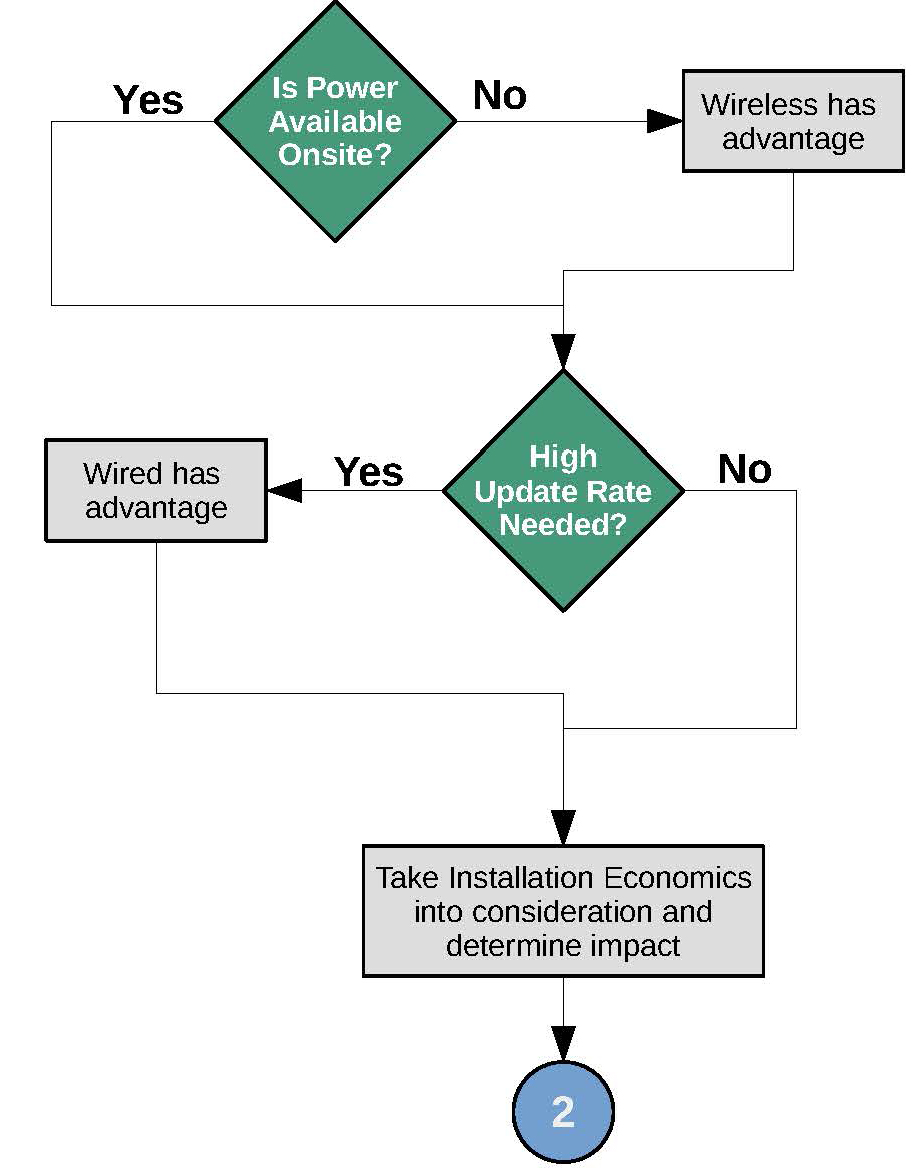 Next, you should consider how often data needs to be updated.
Next, you should consider how often data needs to be updated.
With a wireless system, the power budget is very important as battery life is dependent on update rates, battery capacity, and system power level requirements. To help extend the battery life, many wireless instruments can be outfitted with a rechargeable battery and an attached solar panel charging system. Even with a solar panel and charger one must still be mindful of update rates, as fast update rates can drastically reduce battery life. On one hand, solar panel charging systems work great when they are placed in optimal conditions; on the other hand, the installation location can make them impractical which results in wireless instruments needing their batteries replaced when they run out. If your system has a high update rate, the cost of replacement batteries can become substantial and even more so if the system has many battery-powered devices. Under these conditions, wired instruments have the advantage.
As previously stated, the device economics and power costs probably won’t be the reason you choose wired or wireless instruments; they are factors you should keep them in mind when determining the impact of installation costs, which are normally the most influential economic factors.
Installation Costs
When determining installation costs, a wired instrument can become very expensive as the cost for installing conduit duct banks, copper wire, and time required for the installation can all rapidly increase.This leads us to the first consideration of whether it is a new installation or if it is replacing an existing wired system.
We will start down the path for an existing installation. First of all, you need to determine if the system can be replaced.
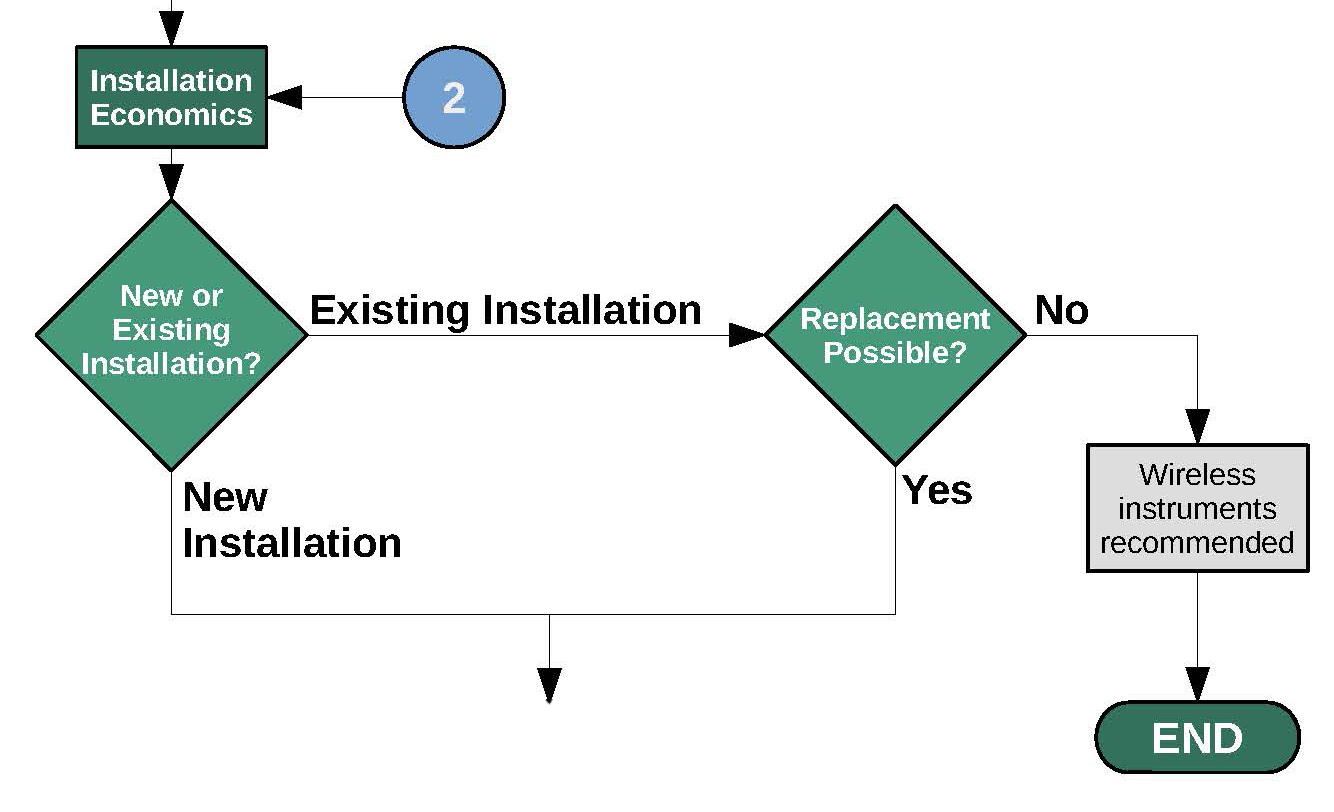 With wired systems, a significant challenge becomes apparent when looking at hazardous locations where conduit duct banks are already installed. The conduit seals used in hazardous locations are practically impossible to break, making replacement of the existing wiring impractical. Instead, the new conduit would need to be run and coupled with larger conduit in a non-classified area.
With wired systems, a significant challenge becomes apparent when looking at hazardous locations where conduit duct banks are already installed. The conduit seals used in hazardous locations are practically impossible to break, making replacement of the existing wiring impractical. Instead, the new conduit would need to be run and coupled with larger conduit in a non-classified area.
In addition to hazardous locations, replacing the system of a critical application or continuous process is also unlikely. These systems may not be able to shutdown because of lost production costs or other reasons that require the process and system stay operational. Although new wires can be pulled and added to the conduits that have been in place, pulling new wire has the risk of creating potential failures to the existing systems. These failures might be immediate or more intermittent over a longer span of time, which can be hard to diagnose and troubleshoot.
If you are faced with an existing system that cannot be replaced, risk mitigation to running processes is most important. Under these circumstances, wireless instruments would be the better choice as installing them will have little to no impact on the system currently in place. Once finished, the process can transition to using the new wireless system and, if possible, the existing wired system can be removed.
Conversely, if the process can be shutdown and the system can be replaced, you are essentially looking at a new installation. Next, we will compare the actual costs of installation which are primarily dependent on the location and distance.
Location
The first question about location asks if the installation is occurring in the air or on the ground; however, we are really trying to answer the underlying question of if there is equipment that needs to be rented.
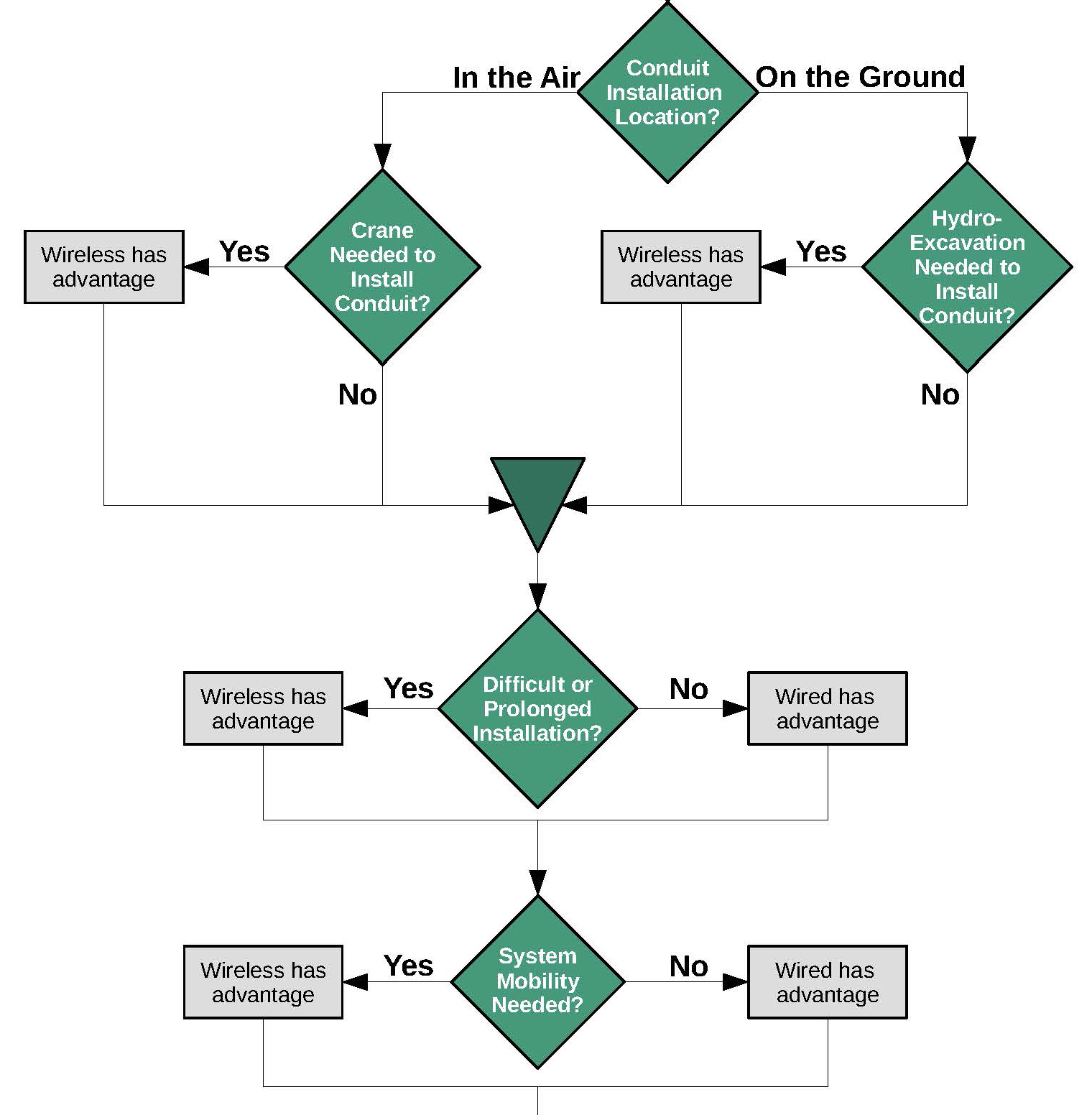 If conduit needs to go up many feet in the air (e.g. on top a storage tank), it may require the use of either a crane or man-lift to perform the installation. Likewise, with ground installations there is frequently material that must be removed from the ground to install conduit. Digging for new conduit can be tedious, time consuming, and costly, so many companies resort to hydro-excavation to remove material to lay in new conduit. If equipment must be rented to install conduit, wireless instruments have the economic advantage.
If conduit needs to go up many feet in the air (e.g. on top a storage tank), it may require the use of either a crane or man-lift to perform the installation. Likewise, with ground installations there is frequently material that must be removed from the ground to install conduit. Digging for new conduit can be tedious, time consuming, and costly, so many companies resort to hydro-excavation to remove material to lay in new conduit. If equipment must be rented to install conduit, wireless instruments have the economic advantage.
Next, we must consider if installing conduit will be difficult or take a prolonged period of time. For instance, installing conduit in a confined space can be both tedious and take a long amount of time for a single technician to complete. In this situation, wireless instruments provide a desirable solution in terms of ease of installation. While it may be difficult to quantify, installation ease can be a big reason that leads one to use wireless instruments.
The last question related to location asks if the system needs to move location frequently. Since they allow equipment to move freely without being tethered to a location, wireless instruments clearly have an advantage in mobility.
Distance
The final factor you must consider is distance from the instruments to the controller. To illuminate the economic impact of distance, let us look at some real-life examples.
Two separate studies of a wired versus wireless system were conducted on a feed mill and an ethanol plant. The parameters for the first study included a length of approximately 1000 feet from end devices to location of controller, as well as a 120 foot run up to the top of the conveyor. This resulted in a need for over 1100 feet of conduit and the potential cost of a man lift or crane for conduit installation. From the first study, the costs were estimated at over $100,000 for the wired system and $55,000 for the wireless system. For the second study, the overall distance was around 3000 feet; the wired system cost was estimated at $270,000 and the wireless system cost at $65,000 (Dittbenner, “Wired vs. Wireless System Comparison”). In both studies the runs were quite long which not only increases the cost of cable and conduit, but significantly raises the installation labor.
Section of the decision tree determining
If the distance is less than 25 feet, a wireless solution will probably not make sense from an economic standpoint. On the other hand, If the distance exceeds 25 feet a wireless solution is recommended as it will likely cost significantly less than a wired solution.
Other Wireless Costs
While not shown on the decision tree, if wireless instruments seem like the best choice there are some other costs you should keep in mind.
Although a wireless system installation can be as simple as pointing the end-device’s antenna at the controller’s antenna, not all wireless installations are problem free and without additional cost considerations. In situations with very long-distance communication (greater than half a mile), a path study may be required to ensure that the antennas will not have interference from the surroundings. Path studies look at many factors to validate that the communication channel will have enough signal present so that the communications are reliable. These path studies examine foliage, radio topology, terrain, frequency, and antenna gain to help determine the proper antenna placement and height.
Additional costs to wireless systems may include protective devices such as RF specific surge suppression or structures to support antenna heights needed to achieve a reliable communications channel, which can be very costly to design and build.
Conclusion
This brings you to the end of the decision tree. Depending on your application, it may not provide a definitive answer of which technology you should use; however, you are now aware of the many, and sometimes overlooked, factors that come into play and whether wired or wireless instruments have the advantage.
You might decide to prioritize ease of installation over the most cost-effective choice, or you may choose to go wired because reliability is your primary objective. Ultimately, every situation is unique, and the optimal solution will always depend on which factors are the highest priorities to you.
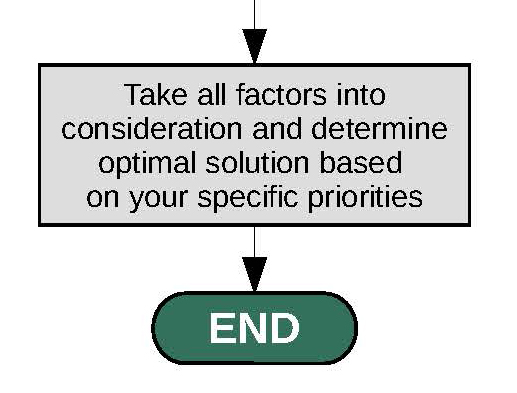
References
Nai-Fovino, Igor, et al. “Design and Implementation of a Secure Modbus Protocol”. Critical Infrastructure Protection III, edited by Charles Palmer and Sujeet Shenoi, Springer, 2009, pp. 93-94.
Dittbenner, Adam. “Wired vs. Wireless System Comparison.” Automation World, 21 Nov. 2016, www.automationworld.com/products/networks/blog/13316381/wired-vs-wireless-system-comparison. Accessed April 2020.
 Michael Bequette, P.E. – VP of Engineering SOR, Inc.
Michael Bequette, P.E. – VP of Engineering SOR, Inc.
Michael Bequette has dual undergraduate degrees in Electrical Engineering, and Theoretical Physics from Kansas State University. He has a Master’s Degree in Electrical Engineering from the University of Kansas, and a Master of Business Administration from Park University. Michael has 23 years of experience in the oil and gas space, as well as aerospace, glass, pulp and paper, and water/wastewater. Michael is a licensed professional engineer in multiple states, holds 4 patents for fiber optic product development and capacitive fault location and is a senior member of IEEE.
 Matthew Giunta – Product Manager SOR, Inc.
Matthew Giunta – Product Manager SOR, Inc.
Matthew Giunta is a graduate of the University of Kansas with a Bachelor of Science in Chemical Engineering. Before coming to SOR, he worked as a Field Engineer cementing wells in the Permian Basin and as a Clinical Research Technician processing biological samples for investigational drug studies. Matthew is a Product Manager at SOR and is responsible for overall product line management. He has also served as an Inside Sales Engineer handling MRO business and supporting SOR sales representatives and customers for the western region of North America.
